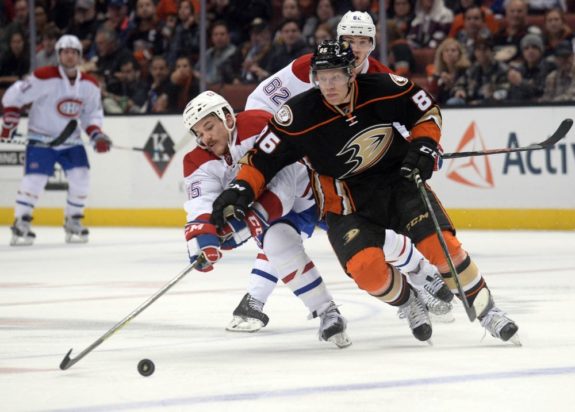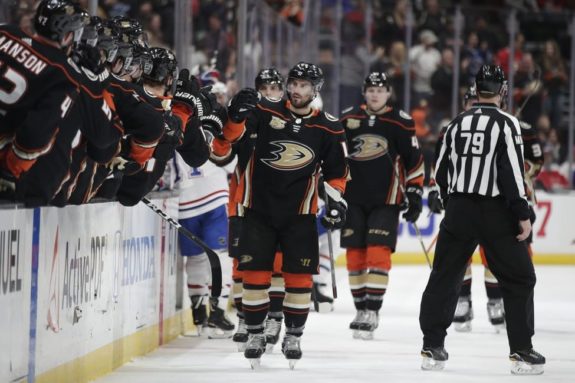The Anaheim Ducks need help improving their defensive group, but trading Ondrej Kase, as the rumors suggest, shouldn’t be the avenue they explore. They should be more interested in increasing his ice time and keeping him as a core piece of their roster for the next several years.
Kase only appeared in 30 games for the Ducks during the 2018-19 season, but he was their best player. His ice time at 5-v-5 has increased from season to season, going from 11:23 in 2016-17 to 12:49 in 2018-19, but it should have been more. If Ryan Getzlaf is going to play 15 minutes a night at 5-v-5, then Kase should be beside him for every second of those minutes. Kase is a player who generates chances for himself and others, and he has documented success to support this.
Offensively, Kase has outperformed the Ducks forwards since 2017-18. Of the nine forwards who played at least 1000 minutes at 5-v-5 over the past two seasons, Kase is tops with a points-per-60 of 2.23. He’s also the only player (among Ducks forwards) to finish the season north of 2.00 points-per-60 in each of the last two seasons. Only 79 of the 348 forwards in the NHL who played 1000 minutes of 5-v-5 over the past two seasons have recorded a points-per-60 of at least 2.00. His individual number of 2.23 ranks 36th overall, where he finds himself in some pretty good company.

Directly above him in 35th with a 2.25 mark is Jack Eichel. There are seven players tied for 37th with 2.22: Matt Duchene, Phil Kessel, Jonathan Huberdeau, Paul Statsny, Jonathan Marchessault, Jamie Benn, and Dylan Strome. Outside of Dylan Strome’s 12:17 average ice time per game at 5-v-5 over that time period, Kase is 1:32 behind the next closest player in that group. That’s unacceptable for a team that struggles to hit the scoresheet.
Kase was particularly dominant in 2018-19 in 30 games, but his 66-game season in 2017-18 was also strong. Here’s a quick look at some relative numbers from Kase’s last two seasons.
| Statistic | 2017-18 | 2018-19 |
| rel CA60 | -3.75 | -9.82 |
| rel CF60 | 4.74 | 13.02 |
| rel SCA60 | -3.9 | -6.44 |
| rel SCF60 | 1.83 | 7.79 |
| rel HDCA60 | -2.07 | -2.16 |
| rel HDCF60 | 0.63 | 4.47 |
If we went strictly by numbers and placed Kase beside some of the NHL’s elite, without player names, it would be difficult to tell the difference. The Ducks have a weapon they aren’t properly using. Offensively and defensively, the Ducks enjoy a lot more success when Kase is on the ice. If his 66-game season wasn’t as strong as it is was, then, maybe, you could question the numbers from his 30-game season, but that isn’t the case.
He brings more chances-for in all categories – shot attempts, scoring chances, and high-danger chances. On defense, he doubles down and provides the Ducks with less chances-against across the same three categories. Being consistently good is not an easy task.
Kase Did the Heavy Lifting on His Lines
If we quickly look at his time playing with his two most common centers during the 2018-19 season, Getzlaf (173 of 384 minutes) and Adam Henrique (179 of 384 minutes), it shows that Kase isn’t being carried by either player.

When he was with Getzlaf, they dominated at 5-v-5, with a CF% of 60.40%. They also enjoyed an expected-goals-for percentage of 56.15%, which they exceeded in actual goals-for percentage (57.89%). In Getzlaf’s other 839 minutes of 5-v-5, he dropped to a 48.75% Corsi-for and 44.80% xGF%. For the remainder of Kase’s 5-v-5 time, he maintains a Corsi-for percentage over 50% (53.65%), and his xGF% only drops to 55.12.
With Henrique, together they weren’t as dominant, but Henrique still, like Getzlaf, performs better with Kase than without him. Together, they posted a 50.98% Corsi-for and a 54.01% xGF%. When Henrique wasn’t with Kase, he put up at 45.20% Corsi-for and a 46.09% xGF%. Kase’s numbers away from Henrique are essentially the same as with Getzlaf because of the number of minutes played. In both cases, Kase elevates his line’s general play significantly while he continues to produce offensively.
The Ducks have one of the most productive wingers in the league at 5-v-5, and they aren’t consistently using him as much as they should. When he’s on the ice, the Ducks generate more chances-for and allow less chances-against, and he does so at a star level. Kase is a player that they should sign long-term as a core piece of their roster, not one to trade at 23 years old. He is a player that, if they choose to trade, will haunt them for several years.
*all stats via naturalstattrick.com